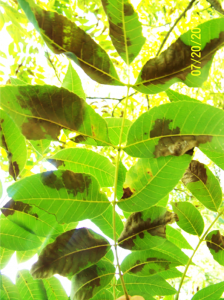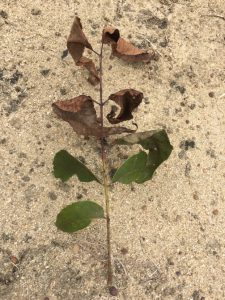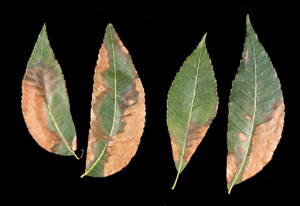We have reached the time of year when we begin to see a lot of odd things happening to the foliage of pecan trees. The long season is coming to a close and the trees are beginning to shift gears a little as some nutrients have moved from the leaves to the nuts and others will soon be going from the leaves to the roots.
I have had a number of calls beginning around the middle of last week regarding some leaf scorching/dropping. There are a number of things at play here and deciphering which one you are dealing with can be tricky.
In some cases the foliage is scorching at random locations on the leaflet and there is no set pattern to the scorching. In most cases this will turn out to be anthracnose. Anthracnose is a complex of minor foliar pathogens that cause leaf scorch but they infect several weeks before you see symptoms. Once you begin to see the symptoms there is nothing you can do about it. This usually occurs when we spray a lot of Elast or Tin during the nut sizing period. While these materials are great on nut scab, they don’t do much for anthracnose. Rotating in Absolute, Amistar Top, or any Group 3 +Group 11 fungicide between Elast sprays or including a group 3 fungicide or a phosphite with Elast can help minimize your chances for infection. Sometimes, the timing just catches you if you happen to be spraying Elast when the conditions for anthracnose occur even if you are rotating.
Another type of scorching that may occur is terminal die-back, caused by a fungus called Neofusicoccum. With this problem, the compound leaf will begin to scorch from the tip backward, often killing the whole compound leaf, including the midrib or leaf stem. This looks bad but rarely causes enough damage to be harmful. It infects under similar conditions as anthracnose and the same chemistry should control it but once you see it, its too late.
Bacterial leaf scorch may appear usually on Cape Fear or Pawnee trees when they become stressed. This problem results from a bacteria that plugs up the xylem (water conducting tissue) of the plant so that the symptoms mimic that of trees suffering from drought. We are learning that the bacterium causing this disease is likely out there in almost every tree of any variety and in many species of trees out there aside from pecan. For some reason symptoms are most easily expressed in Cape Fear and Pawnee trees (and a few others). Symptom expression is usually triggered by a stress event whether that event be crop load or an emitter stopping up or some other form of stress. There is nothing you can spray for this disease. Symptoms usually go away the following year if the scorching did not get too severe and the stress problem is corrected. Pruning often helps in severe cases.
You may also observe leaves turning yellow and falling off, which is the most common problem I see right now. This is the result of shading and/or dry weather and may result in the loss of compound leaves or leaflets. If shading is the culprit, you will see most of the leaf yellowing and shedding occurring within the inside of the tree canopy in the shade. Nothing you can do for it if you are seeing it currently but this may be a sign you need to open up the orchard to more sunlight either through tree thinning or hedging.
The dry weather we have had over the last few weeks has led to some early leaf senescence that will also look like the symptoms of shading. This will normally occur where trees are not receiving enough water. Up until about now, you should have been running your irrigation systems at full capacity to fill the kernels if you have a crop. Most nuts I have cut since the end of last week are full of kernel at this point. This means you can cut back on the water but by no means should you cut it off.
Your irrigation should still be at 50-60% of full capacity, cutting back to 40% in October and continuing to water until you are about a week away from shaking. Many Pawnee orchards are already to this point and if you plan on shaking Pawnee within the next week you should turn the water off now but don’t be surprised if you start to see some leaves drop after several days. Turning off irrigation about 5 days ahead of shaking Pawnee helps to minimize shaker damage to the bark.





